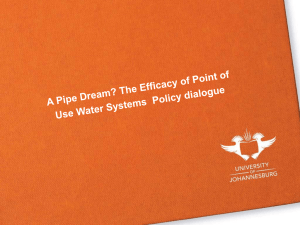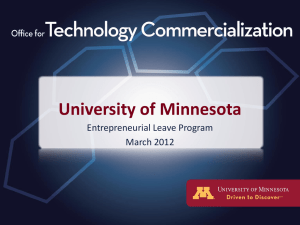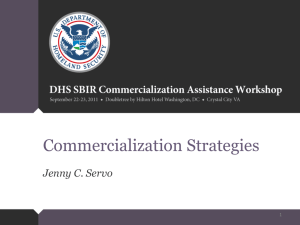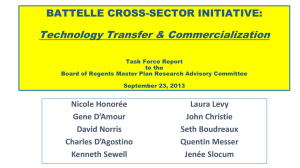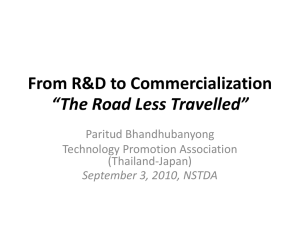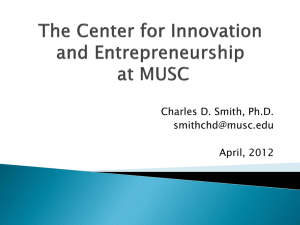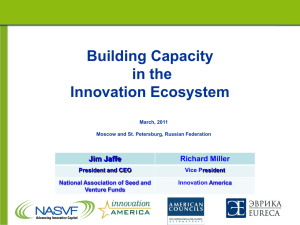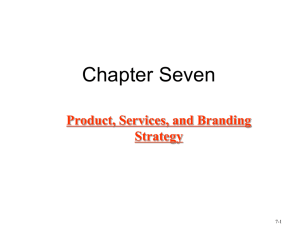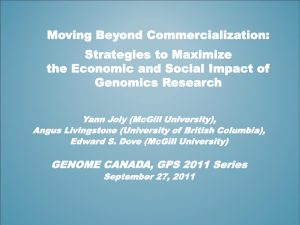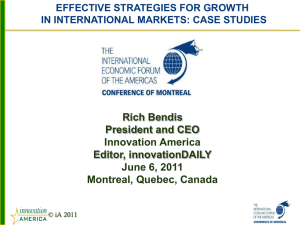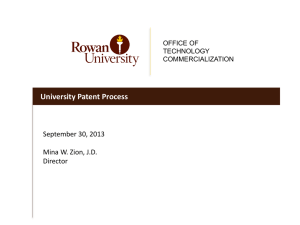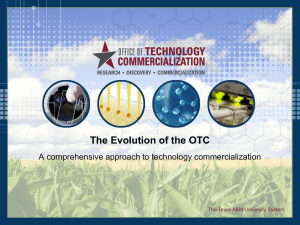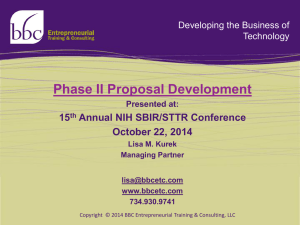Accelerated Commercialization
advertisement
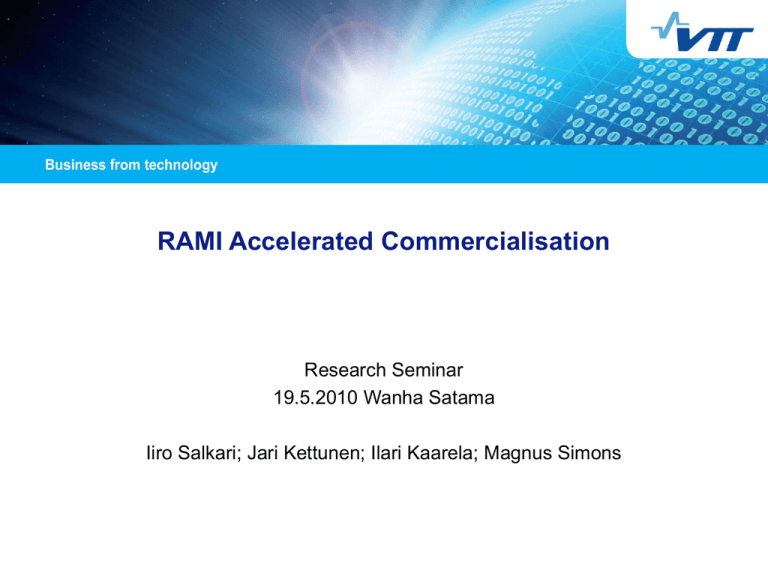
RAMI Accelerated Commercialisation Research Seminar 19.5.2010 Wanha Satama Iiro Salkari; Jari Kettunen; Ilari Kaarela; Magnus Simons 13/04/2015 Agenda Research topic and goals Case comparison Key challenges in forest cluster Potential solutions Final report structure 2 13/04/2015 3 Research topic and goals Research topic While developing new technologies, choices, that have an influence in their commercialization, are made. Technologies can be commercialized at different maturity stages for different customer segments. How do these topics affect commercialization in different stages of technology development? What are the special characteristics of the forest cluster that may impact on commercialization? Goals Models and methods that support accelerated commercialization at different stages of technology development. Identifying the changes to existing value networks that successful commercialization may require. 13/04/2015 4 General challenges of innovation management Identified market Technology generations Identified market Technology push •Partners •Partners •Partners •Organising •Organising •Organising •Financing •Financing •Financing •Making space •Making space •Making space Market pull Selected, initially targeted market Identified market Identified market 13/04/2015 5 Case comparison, 1/2 Case Hot embossing Bio-latex Fractionation Technology Printing of optical effects on normal packaging and printing materials Production of latex-like products from wood-based materials, such as hemicelluloses Dividing wood material into two separate fractions according to fiber properties Applications Brand promotion: decorative effects Brand protection: hidden codes that can be made visible using laser illumination Wood-based polymers for dispersion and extrusion coating, and non-woven materials Fractionation as an integrated part of a pulping factory Customers Brand owners operating their own packaging line Packaging service providers Printing houses Paperboard, plastic and packaging companies aiming for environmental sustainability Pulping factories aiming for higher selectivity in fiber properties and/or energy/chemical savings Benefits Ability to produce high quality effects on various substrates using either no coatings or environmentally friendly coatings (no metals needed) Reducing oil-dependency in latex (and possibly plastic) products Reducing energy consumption in mechanical pulping Reducing chemical consumption in chemical pulping Allowing increased usage of cheaper pine material Phase Industrial pilot possible in quite near future Start-up in preparation, potential investors being contacted Business model development underway Further research on polymers Improving physical properties Still in the process of proving the concept 13/04/2015 6 Case comparison, 2/2 Case Hot embossing Bio-latex Fractionation Open questions Market size Allowable premium (cost/package) Economic scale of production Scope of offering, feasible business model Availability and price of materials (hemicellulose) Acceptable premium Actual market value of ‘greenness’ Key challenges A full-scale pilot is relatively expensive (difficult to get started) Customers for the technology not willing to invest unless their customers signal clear demand Customers for the technology may demand exclusivity Brand owners do not want dependence on one supplier Difficulties in narrowing down to a reasonable set of potential applications Setting the required levels of physical properties and reaching those properties Expert knowledge is very dispersed Full process from raw materials to final products difficult to grasp, and even minute changes in the process concept can turn to large ones in the value chain Finding suitable commercial partners Lessons learned Traditional market studies do not help Need to demonstrate technology and get a reference thru a full-scale pilot Active marketing towards brand owners essential Impossible to predict how long it takes to commit prospective customers Lack of funding may significantly delay the process The commercialization would affect many existing commercial value chains, and all the involved parties must be convinced of the resulting benefits Need to focus on potential commercially feasible applications early on It is difficult to forecast how the fractionation process would alter the existing value chains – separate customers for different fibers? raw Rationale of the whole process of fractionation Significance of the savings in energy and chemicals compared to reductions in pulping process yield 13/04/2015 7 Key challenges of the forest cluster, 1/2 Volume business paradigm High volumes and operational efficiency alone count If it does not scale-up fast, it is not interesting Capital intensiveness Need to secure a high capacity factor, ROI R&D focus almost solely on the core process and equipment Expensive pilots Need for dedicated labs, facilities High threshold for testing new ideas and concepts Rigid value chain Must convince a number of interlinked market participants High costs and risks, and lack of trust discourage change 13/04/2015 8 Key challenges of the forest cluster, 2/2 Efficiency focus People are not encouraged to ‘look around’ “If it does not reduce costs, it is a cost item, not an investment” Growth in emerging markets Volume business paradigm works well in the emerging markets What are the true incentives for radical change? Silo thinking (Fordism) Production process determines the organization Expertise is fragmented, knowledge integration is challenging Research vs. markets The focus of R&D has been on the process, and researchers have not been expected to explore new business opportunities 13/04/2015 9 Solutions, 1/2 Business case for the whole value chain Things won't proceed unless all participants will find it broadly beneficial to get involved Full scale industrial pilot Pilots are indispensable, but expensive The implementation and financing of a pilot should be planned early on Small internal businesses must be allowed space to grow High volumes cannot be required in the short-term Internal venturing organizations with capable people and a strong mandate and resources 13/04/2015 10 Solutions, 2/2 Concurrent commercialization Technology and business development shall proceed in parallel Experimental development and piloting around new product and service ideas and concepts Short-term commercial interest cannot guide R&D work if the build it competitive advantage on deep technological knowhow Challenging the strategy The investments decisions regarding technologies, products and services should reflect the best available understanding of one's opportunities in the market, not only the chosen strategy Certain percentage of the firm's development funds should be reserved to the exploration of 'new frontiers' 13/04/2015 11 Final report structure Defining the strategy Positioning Competitive advantage Implementing the strategy Portfolio management Resourcing Organizing and networking Challenging the strategy Higher level of abstraction Strategy Strategies Where do we want to go/ be? Business models How are we going to make money? Process models How to implement the business models? Concept and business model development Technology risk and fit Market risk and fit Market structure evaluation Innovation process Parallel activies Critical path? Lower level of abstraction Market / Value chain analysis 13/04/2015 VTT creates business from technology 12
